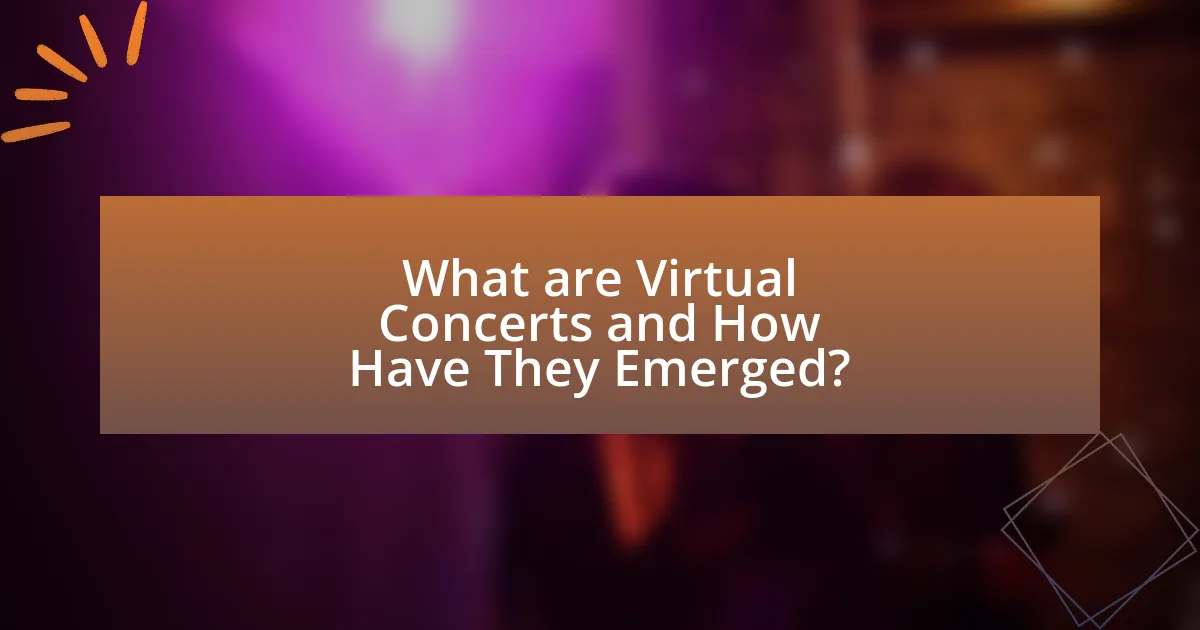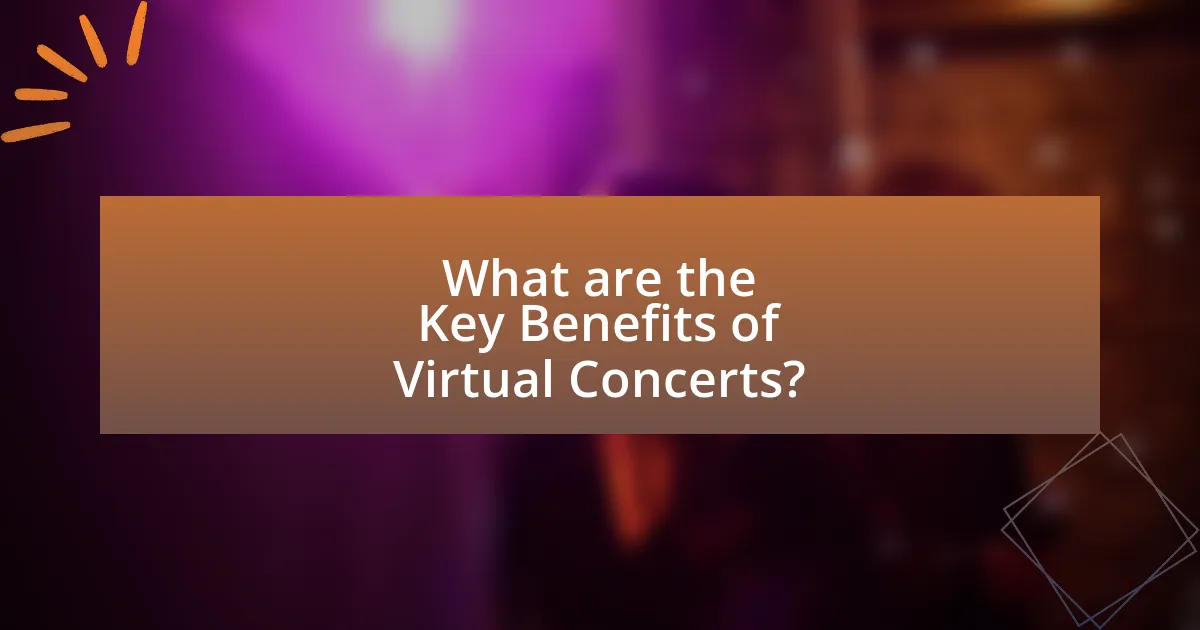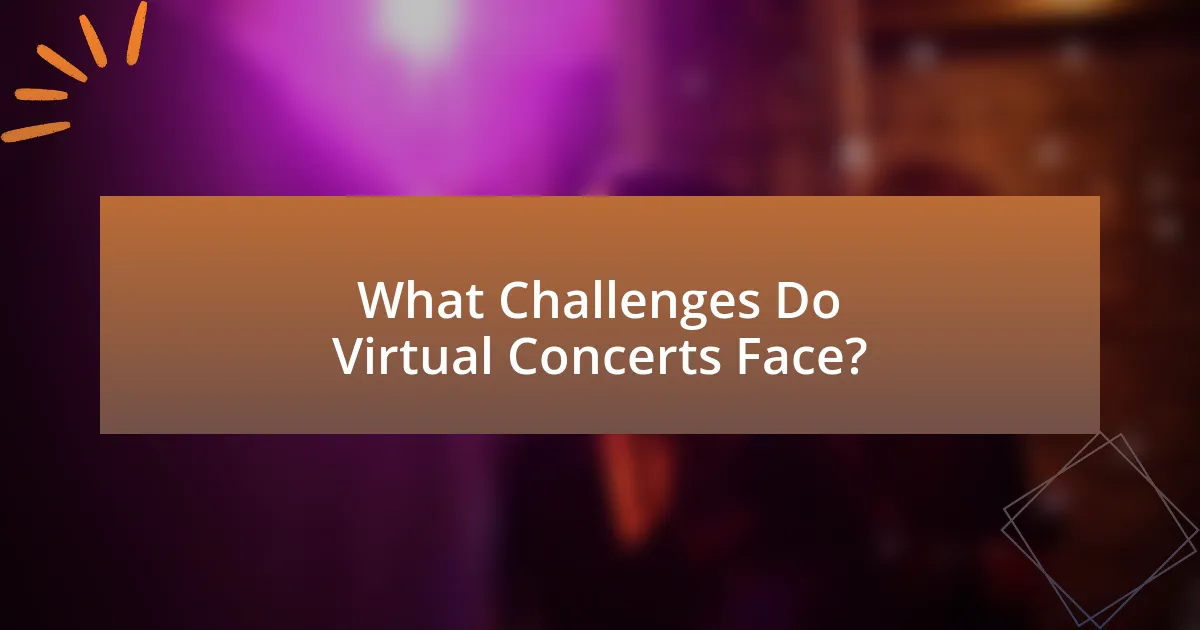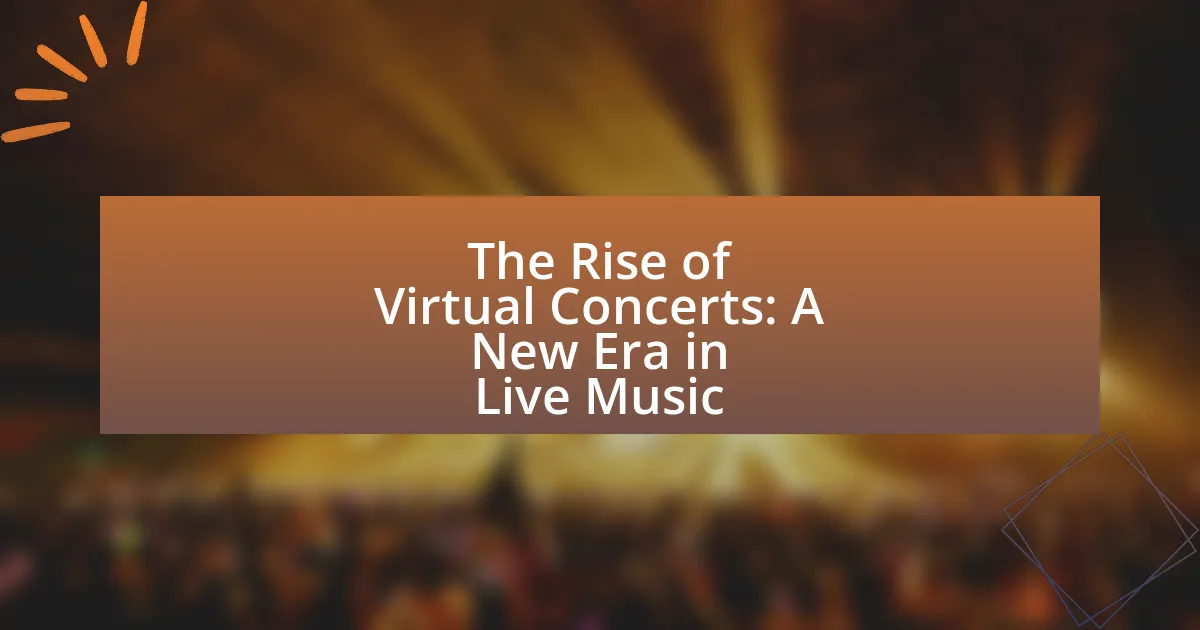Virtual concerts represent a significant evolution in the live music industry, allowing audiences to experience performances remotely through digital platforms. The rise of these events has been fueled by technological advancements and the impact of the COVID-19 pandemic, which necessitated social distancing and led to a surge in online performances. This article explores the differences between virtual and traditional concerts, the technologies that enable them, and the changing audience experience. It also examines the financial advantages for artists, the challenges faced in delivering virtual events, and the potential coexistence of virtual concerts with traditional live performances. Key benefits such as accessibility, cost-effectiveness, and enhanced audience engagement are highlighted, alongside strategies for successful virtual concert hosting and promotion.

What are Virtual Concerts and How Have They Emerged?
Virtual concerts are live music performances that occur in a digital environment, allowing audiences to experience the event remotely through streaming platforms. They have emerged significantly due to advancements in technology and the necessity for social distancing during the COVID-19 pandemic, which accelerated the adoption of virtual events. According to a report by Midia Research, the global virtual concert market was valued at approximately $6 billion in 2020, highlighting the rapid growth and acceptance of this format. Artists and promoters have increasingly utilized platforms like Twitch, YouTube, and social media to reach wider audiences, demonstrating a shift in how live music is consumed.
How do Virtual Concerts differ from Traditional Live Concerts?
Virtual concerts differ from traditional live concerts primarily in their format and accessibility. Virtual concerts are conducted online, allowing audiences to participate from anywhere with an internet connection, while traditional live concerts require physical attendance at a specific venue. This shift to a digital platform enables artists to reach a global audience without geographical limitations, as evidenced by events like Travis Scott’s virtual concert in Fortnite, which attracted over 12 million viewers simultaneously. Additionally, virtual concerts often incorporate interactive elements, such as real-time chat and augmented reality features, enhancing audience engagement compared to the more passive experience of traditional concerts.
What technologies enable Virtual Concerts?
Virtual concerts are enabled by several key technologies, including high-speed internet, streaming platforms, virtual reality (VR), augmented reality (AR), and advanced audio-visual equipment. High-speed internet allows for seamless transmission of live performances to global audiences, while streaming platforms like YouTube, Twitch, and specialized services facilitate real-time interaction and accessibility. VR and AR technologies enhance the experience by creating immersive environments that simulate live concert settings, allowing users to engage with performances in innovative ways. Advanced audio-visual equipment ensures high-quality sound and visuals, which are crucial for replicating the live concert experience digitally. These technologies collectively transform how audiences experience live music, making virtual concerts a viable alternative to traditional events.
How has the audience experience changed with Virtual Concerts?
The audience experience has significantly changed with virtual concerts by providing greater accessibility and interactivity. Virtual concerts allow fans from around the world to attend performances without geographical limitations, as evidenced by the surge in online viewership during events like Travis Scott’s Fortnite concert, which attracted over 12 million participants. Additionally, virtual platforms often incorporate interactive features such as live chats and social media integration, enhancing audience engagement and creating a sense of community among viewers. This shift has transformed how audiences connect with artists and each other, making live music more inclusive and dynamic.
Why have Virtual Concerts gained popularity in recent years?
Virtual concerts have gained popularity in recent years primarily due to advancements in technology and the impact of the COVID-19 pandemic. The rise of high-speed internet and streaming platforms has made it easier for artists to reach global audiences without geographical limitations. Additionally, during the pandemic, traditional live events were restricted, prompting artists to explore virtual formats as a means to connect with fans. According to a report by Pollstar, the virtual concert market was valued at approximately $6 billion in 2020, highlighting the significant financial potential and audience engagement that these events can generate.
What role did the COVID-19 pandemic play in the rise of Virtual Concerts?
The COVID-19 pandemic significantly accelerated the rise of virtual concerts by forcing live music events to be canceled or postponed due to health restrictions. As traditional venues closed and social distancing measures were implemented, artists and promoters turned to online platforms to reach audiences, leading to a surge in virtual performances. For instance, in 2020, platforms like Instagram Live, YouTube, and Twitch saw a dramatic increase in usage, with artists such as Travis Scott and Billie Eilish hosting successful virtual concerts that attracted millions of viewers. This shift not only provided a new revenue stream for artists during a time of financial uncertainty but also expanded their reach to global audiences, demonstrating the viability of virtual concerts as a permanent fixture in the music industry.
How have social media and streaming platforms influenced this trend?
Social media and streaming platforms have significantly influenced the rise of virtual concerts by providing artists with direct access to global audiences. These platforms enable musicians to broadcast live performances to millions, breaking geographical barriers and allowing for real-time interaction with fans. For instance, during the COVID-19 pandemic, platforms like Instagram Live and Twitch saw a surge in virtual concerts, with artists such as Travis Scott attracting over 12 million viewers for his Fortnite concert, demonstrating the potential reach and engagement that these platforms offer. This shift has not only transformed how concerts are experienced but has also created new revenue streams through virtual ticket sales and merchandise, further solidifying the role of social media and streaming in the evolution of live music.

What are the Key Benefits of Virtual Concerts?
The key benefits of virtual concerts include accessibility, cost-effectiveness, and enhanced audience engagement. Accessibility allows fans from diverse geographical locations to attend performances without travel barriers, significantly increasing audience reach. Cost-effectiveness is evident as virtual concerts often have lower production costs compared to traditional events, allowing artists to invest more in their performances or offer lower ticket prices. Enhanced audience engagement is facilitated through interactive features such as live chats and social media integration, which foster a sense of community among viewers. These benefits have been highlighted in various studies, including a report by Eventbrite, which noted that 75% of attendees appreciated the convenience of attending events from home.
How do Virtual Concerts enhance accessibility for audiences?
Virtual concerts enhance accessibility for audiences by allowing individuals to attend performances from anywhere in the world without geographical or physical barriers. This format enables people with disabilities, those living in remote areas, or individuals unable to afford travel costs to experience live music events. According to a report by the International Federation of the Phonographic Industry, virtual concerts have seen a significant increase in viewership, with millions of attendees participating in online events, demonstrating their broad reach and inclusivity.
What demographic groups benefit most from Virtual Concerts?
Young adults and teenagers benefit most from virtual concerts. This demographic group, typically aged 16 to 34, is highly engaged with digital platforms and social media, making them more likely to participate in online events. According to a report by Eventbrite, 83% of millennials and Gen Z are interested in attending virtual events, highlighting their preference for accessible and innovative experiences. Additionally, individuals with mobility issues or those living in remote areas also gain significant advantages from virtual concerts, as these events eliminate geographical barriers and provide access to performances they might otherwise miss.
How do Virtual Concerts provide opportunities for global reach?
Virtual concerts provide opportunities for global reach by utilizing online platforms that allow artists to perform for audiences worldwide without geographical limitations. These events can be streamed live or recorded, enabling fans from different countries to participate simultaneously or access performances at their convenience. For instance, platforms like YouTube, Twitch, and specialized concert services have hosted events that attracted millions of viewers globally, demonstrating the potential for artists to connect with diverse audiences. Additionally, virtual concerts often feature interactive elements, such as live chats and social media integration, which enhance audience engagement and foster a sense of community across borders.
What financial advantages do artists gain from Virtual Concerts?
Artists gain significant financial advantages from virtual concerts, primarily through reduced overhead costs and expanded audience reach. Virtual concerts eliminate expenses associated with physical venues, such as rental fees, staffing, and logistics, allowing artists to retain a larger share of ticket sales. For instance, a study by Eventbrite in 2021 indicated that artists could earn up to 80% of ticket revenue from virtual events compared to 30-50% from traditional concerts. Additionally, virtual concerts enable artists to reach global audiences without geographical limitations, increasing potential ticket sales and merchandise revenue. This model has been particularly beneficial during the COVID-19 pandemic, where traditional concert opportunities were severely restricted, demonstrating the financial viability of virtual performances.
How do Virtual Concerts reduce overhead costs for artists and venues?
Virtual concerts significantly reduce overhead costs for artists and venues by eliminating expenses associated with physical venues, staffing, and logistics. Artists save on venue rental fees, equipment transportation, and on-site personnel costs, while venues avoid maintenance and operational expenses. For instance, a traditional concert may incur costs exceeding $100,000 for venue rental and staffing, whereas a virtual concert can be executed with minimal technical setup and fewer personnel, often costing less than $10,000. This cost efficiency allows artists to retain a larger share of their revenue and enables venues to operate with lower financial risk, making virtual concerts a financially viable alternative in the live music industry.
What new revenue streams are created through Virtual Concerts?
Virtual concerts create new revenue streams through ticket sales, merchandise sales, sponsorships, and digital content monetization. Ticket sales for virtual events often include tiered pricing models, allowing fans to choose from various access levels, which can increase overall revenue. Merchandise sales are facilitated through online platforms, enabling artists to reach a global audience without geographical limitations. Sponsorships from brands seeking to engage with the digital audience provide additional financial support, as companies invest in promoting their products during these events. Furthermore, digital content monetization, such as exclusive behind-the-scenes footage or recorded performances, allows artists to generate income long after the live event has concluded. These revenue streams have been increasingly recognized, with the global virtual concert market projected to reach $6 billion by 2027, highlighting the financial potential of this new format.

What Challenges Do Virtual Concerts Face?
Virtual concerts face several challenges, including technical issues, audience engagement, and monetization difficulties. Technical issues can arise from internet connectivity problems, software glitches, or inadequate streaming quality, which can detract from the viewer experience. Audience engagement is another significant challenge, as virtual formats lack the physical presence and energy of live performances, making it harder to connect with fans. Additionally, monetization poses difficulties; artists often struggle to generate revenue comparable to traditional concerts due to lower ticket prices and the prevalence of free streaming options. These challenges highlight the complexities of delivering a successful virtual concert experience.
What technical issues can arise during Virtual Concerts?
Technical issues that can arise during virtual concerts include connectivity problems, audio and video synchronization issues, and platform limitations. Connectivity problems often lead to buffering or lag, which disrupts the viewing experience; for instance, a study by the Pew Research Center found that 53% of users experience internet connectivity issues during live streaming events. Audio and video synchronization issues can result in a disjointed experience, where the sound does not match the visuals, affecting audience engagement. Additionally, platform limitations may restrict the number of viewers or the quality of the stream, as seen in events that exceed the hosting platform’s capacity, leading to crashes or degraded performance.
How can artists and organizers prepare for potential technical difficulties?
Artists and organizers can prepare for potential technical difficulties by conducting thorough pre-event testing of all equipment and software. This includes checking internet connectivity, audio and video quality, and backup systems to ensure a seamless experience. According to a study by the International Live Events Association, 70% of technical issues can be mitigated through proper rehearsal and equipment checks. Additionally, having a dedicated technical support team on standby during the event can quickly address any unforeseen issues, further minimizing disruptions.
What are the common pitfalls in streaming quality and audience engagement?
Common pitfalls in streaming quality and audience engagement include poor internet connectivity, inadequate audio and video quality, and lack of interactive features. Poor internet connectivity can lead to buffering and interruptions, which frustrate viewers and diminish their experience. Inadequate audio and video quality can result in a lack of clarity, making it difficult for the audience to enjoy the performance. Additionally, a lack of interactive features, such as live chats or polls, can reduce audience engagement, as viewers may feel disconnected from the event. These factors collectively contribute to a negative streaming experience, impacting both viewer retention and satisfaction.
How do Virtual Concerts impact the traditional music industry?
Virtual concerts significantly disrupt the traditional music industry by altering revenue streams and audience engagement. They provide artists with a platform to reach global audiences without geographical limitations, which contrasts with the localized nature of traditional concerts. For instance, in 2020, the virtual concert market was valued at approximately $1.1 billion and is projected to grow, indicating a shift in how music is consumed. Additionally, virtual concerts often reduce overhead costs associated with physical venues, allowing artists to retain a larger share of ticket sales. This shift has prompted traditional venues and promoters to adapt their business models, integrating hybrid events that combine in-person and virtual experiences to remain competitive.
What concerns do industry professionals have regarding the future of live music?
Industry professionals express concerns about the future of live music primarily due to the increasing prevalence of virtual concerts, which may diminish the traditional live experience. They worry that the shift towards digital platforms could lead to reduced audience engagement and a decline in ticket sales for in-person events. According to a survey conducted by the International Live Music Conference in 2022, 67% of industry stakeholders believe that virtual concerts could undermine the financial viability of live performances, as audiences may prefer the convenience of attending events from home. Additionally, there are apprehensions about the potential loss of community and connection that live music fosters, which is difficult to replicate in a virtual setting.
How can Virtual Concerts coexist with traditional live performances?
Virtual concerts can coexist with traditional live performances by offering complementary experiences that cater to different audience preferences and accessibility needs. Virtual concerts provide a platform for artists to reach global audiences without geographical limitations, while traditional live performances create unique, immersive experiences that foster community and connection among attendees. According to a 2021 report by the International Federation of the Phonographic Industry, 50% of music consumers expressed interest in attending virtual events, indicating a significant market for both formats. This coexistence allows artists to diversify their revenue streams and engage with fans in multiple ways, enhancing the overall music experience.
What are Best Practices for Hosting a Successful Virtual Concert?
Best practices for hosting a successful virtual concert include ensuring high-quality audio and video, engaging with the audience through interactive features, and promoting the event effectively across multiple platforms. High-quality audio and video are crucial as they directly impact the viewer’s experience; for instance, a study by the International Federation of the Phonographic Industry found that 70% of viewers prioritize sound quality in virtual performances. Engaging with the audience can be achieved through live chats, Q&A sessions, and social media interactions, which foster a sense of community and connection. Effective promotion involves utilizing social media, email newsletters, and collaborations with influencers to reach a wider audience, as evidenced by a report from Eventbrite indicating that 80% of attendees discover events through social media channels.
How can artists effectively promote their Virtual Concerts?
Artists can effectively promote their virtual concerts by leveraging social media platforms, engaging with their fan base, and utilizing targeted advertising. Social media allows artists to reach a wide audience quickly; for instance, platforms like Instagram and TikTok have proven effective for music promotion, with 67% of users discovering new music through these channels. Engaging with fans through live Q&A sessions or behind-the-scenes content can create excitement and anticipation for the concert. Additionally, targeted advertising on platforms like Facebook can help reach specific demographics, increasing ticket sales and viewership. These strategies are supported by data showing that artists who actively engage with their audience see higher attendance rates at virtual events.
What strategies can enhance audience interaction during Virtual Concerts?
To enhance audience interaction during virtual concerts, implementing real-time chat features and interactive polls is essential. Real-time chat allows attendees to communicate with each other and the performers, fostering a sense of community. Interactive polls can engage the audience by allowing them to vote on song selections or provide feedback during the event. According to a study by Eventbrite, 70% of attendees prefer events that offer interactive elements, indicating that these strategies significantly improve audience engagement and satisfaction.
